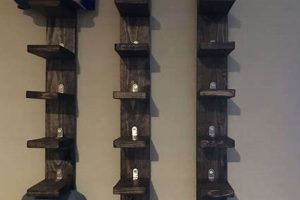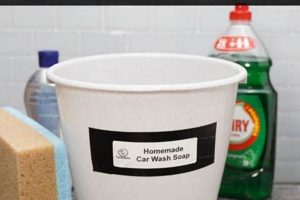A do-it-yourself floral arrangement is the practice of assembling flowers and greenery into a decorative bundle without professional assistance. This activity involves selecting, preparing, and combining various plant materials to create a personalized floral display, often for gifting, home decor, or special events. For example, a collection of garden roses, lavender sprigs, and eucalyptus branches can be arranged and tied together to form a unique handheld presentation.
Creating personalized floral arrangements offers multiple advantages, including cost savings, creative expression, and sentimental value. Historically, arranging flowers has been a practiced skill, often passed down through generations, signifying thoughtfulness and care. The ability to customize flower combinations allows for the selection of blooms that reflect individual preferences, event themes, or convey specific messages through floral symbolism.
The subsequent discussion will delve into the essential tools and materials, step-by-step techniques, flower selection guidance, and design considerations involved in crafting visually appealing and lasting floral compositions from home. Furthermore, it will provide insights into caring for completed projects to maximize their longevity and aesthetic appeal.
Crafting Exceptional Floral Presentations
The following guidance aims to enhance the creation process of personalized floral arrangements, ensuring aesthetically pleasing and enduring results.
Tip 1: Select Fresh, High-Quality Blooms: The longevity and visual appeal of the completed arrangement are directly correlated to the freshness of the flowers. Prioritize flowers with firm stems, vibrant colors, and buds that are beginning to open. Avoid flowers exhibiting signs of wilting, bruising, or discoloration.
Tip 2: Prepare Stems Properly: Remove all foliage below the waterline to prevent bacterial growth and extend the life of the flowers. Cut stems at a 45-degree angle under running water to facilitate water absorption. Re-cut stems every few days to maintain optimal hydration.
Tip 3: Utilize Floral Foam or a Pin Frog: These tools provide support and structure for the arrangement, enabling precise placement of flowers and preventing drooping. Soak floral foam thoroughly before use and secure it within the chosen container. For a pin frog, ensure the base is weighted for stability.
Tip 4: Establish a Focal Point: Designate a dominant flower or grouping of flowers as the focal point to draw the eye and create visual interest. Position the focal point slightly off-center for a more dynamic composition. Use larger or more vibrant blooms for the focal point.
Tip 5: Incorporate Filler Flowers and Greenery: Filler flowers, such as baby’s breath or statice, add texture and volume to the arrangement, complementing the main blooms. Greenery, such as eucalyptus or ferns, provides a backdrop and enhances the overall aesthetic. Maintain balance between focal flowers, fillers, and greenery.
Tip 6: Adhere to a Color Palette: A cohesive color scheme enhances the overall harmony of the arrangement. Consider complementary colors, analogous colors, or monochromatic palettes. Limit the number of colors to prevent visual clutter.
Tip 7: Consider Proportion and Scale: The height and width of the arrangement should be proportionate to the size of the container and the surrounding environment. Avoid arrangements that are too tall or too wide for the available space.
Adhering to these guidelines promotes the creation of visually appealing and enduring floral compositions, enhancing both the aesthetic and sentimental value of the final presentation.
The subsequent sections will provide further detail on advanced arrangement techniques and specific design styles.
1. Freshness
The concept of freshness is paramount in the creation of do-it-yourself floral arrangements. It dictates the overall aesthetic appeal, longevity, and the perceived value of the final product. The subsequent sections detail facets of freshness and their influence on the success of homemade floral presentations.
- Cellular Hydration and Turgidity
Optimal cellular hydration directly correlates to the turgidity, or rigidity, of floral stems and petals. Adequate water uptake prevents wilting and drooping, maintaining the flower’s shape and structure. For instance, roses lacking sufficient hydration will exhibit drooping heads and a loss of petal firmness. This impacts the arrangement’s aesthetic negatively and reduces its lifespan.
- Floral Bud Stage
The stage of bud development at the time of acquisition significantly influences the arrangement’s lifespan. Flowers selected in tight bud form may not fully open, while overly mature blooms will exhibit a shortened display period. A balance, selecting flowers with partially opened buds, provides optimal viewing duration. The timing directly determines how the floral arrangement will visually develop.
- Absence of Physical Damage and Disease
Physical damage, such as bruising or broken stems, accelerates deterioration. Similarly, the presence of disease, indicated by spotting or discoloration, compromises the integrity of the flower. For example, fungal infections can spread rapidly, affecting the entire arrangement. Therefore, careful inspection and selection free of visible defects are critical for ensuring a healthy, aesthetically pleasing arrangement.
- Post-Harvest Handling and Storage
Proper post-harvest handling and storage techniques are essential to preserve freshness. This encompasses temperature control, appropriate humidity levels, and the use of floral preservatives. Incorrect storage, such as exposure to excessive heat, accelerates respiration and ethylene production, leading to premature wilting and senescence. Consistent application of these techniques extends the display life significantly.
The interplay of cellular hydration, bud stage, absence of damage, and proper handling ultimately defines the “freshness” of the flowers utilized in a DIY bouquet. Prioritizing these elements ensures a visually appealing and enduring final product, enhancing the overall satisfaction and perceived value of the handcrafted arrangement.
2. Stem Preparation
Stem preparation is a crucial determinant in the success and longevity of a do-it-yourself floral arrangement. The procedures employed directly impact water uptake, bacterial proliferation, and the overall structural integrity of the floral components. Without proper stem preparation, even the freshest, most vibrant blooms will quickly wilt and degrade, diminishing the aesthetic appeal of the assembled presentation. A common example involves failing to remove foliage below the waterline; submerged leaves decompose, fostering bacterial growth that impedes wat
er absorption, leading to premature decay. The practice of cutting stems at an angle under water prevents air bubbles from blocking the xylem, the vascular tissue responsible for transporting water, effectively maximizing hydration.
The specific techniques employed vary based on the type of flower and foliage. Woody stems, for instance, often benefit from being split or crushed at the base to increase water uptake capacity. Similarly, certain flowers, such as hydrangeas, excrete a sap that can clog the stem; searing the cut end briefly with a flame can prevent this blockage. These detailed processes underscore the practical significance of understanding floral anatomy and physiology in the context of creating a lasting, visually appealing do-it-yourself bouquet. Correct preparation of stems enhances the visual structure of the bouquet.
In conclusion, stem preparation represents a foundational step in the craft of creating a personal floral arrangement. Its proper execution is not merely a matter of aesthetic concern but rather a practical imperative for ensuring the vitality and enduring beauty of the finished product. While seemingly basic, the principles of stem preparation are rooted in a deep understanding of plant biology, highlighting the importance of informed technique in this artistic pursuit.
3. Focal Point
In the context of creating a do-it-yourself floral arrangement, the focal point serves as the primary visual anchor, dictating the overall aesthetic balance and drawing the observer’s attention. Careful consideration of the focal point is crucial for achieving a professionally designed and visually appealing bouquet.
- Dominance and Hierarchy
The focal point establishes a clear visual hierarchy within the arrangement, indicating the most important element. This is typically achieved through the strategic placement of a larger, more vibrant, or uniquely textured flower. For instance, a single, prominent peony surrounded by smaller, less saturated blooms immediately establishes the peony as the focal point. The dominance influences the visual experience of the entire bouquet.
- Color and Texture Contrast
Employing contrasting colors or textures can effectively highlight the focal point. Placing a dark red rose amongst softer, pastel-colored flowers draws the eye to the darker element. Similarly, contrasting smooth petals with rough textures, like the spiky texture of thistle, can create a point of visual interest. A striking juxtaposition of color or texture guides focus.
- Spatial Arrangement and Placement
The strategic placement of the focal point influences the perceived balance and dynamism of the arrangement. An off-center focal point, for example, often creates a more visually engaging and naturalistic design compared to a rigidly symmetrical placement. Furthermore, the angle and direction of the focal flower can guide the eye throughout the entire bouquet. Spatial arrangement is critical to direct viewer attention.
- Scale and Proportion Relationships
The size and scale of the focal point relative to the surrounding elements determine the overall visual harmony. A focal point that is disproportionately large or small can disrupt the balance and detract from the overall aesthetic. A carefully considered scale relationship ensures the focal point complements, rather than overwhelms, the other components of the arrangement. Scale considerations ensure visual harmony.
The effective manipulation of dominance, contrast, spatial arrangement, and scale enables the deliberate creation of a focal point within a do-it-yourself floral arrangement. The focal point is the important aspects for designing a bouquet.
4. Color Harmony
Color harmony constitutes a fundamental design principle governing the aesthetic success of a do-it-yourself floral arrangement. The deliberate selection and combination of hues within a floral presentation directly influence its visual impact and the emotional response it evokes.
- Analogous Color Schemes
Analogous color schemes, derived from colors adjacent to one another on the color wheel, create a sense of visual unity and tranquility. A do-it-yourself bouquet employing various shades of purple, blue-purple, and red-purple exemplifies this principle. This palette fosters a cohesive and calming aesthetic, suitable for settings requiring a serene ambiance. The effect provides gentle color relationship.
- Complementary Color Contrasts
Complementary color schemes involve the pairing of colors located opposite each other on the color wheel, generating a vibrant and dynamic contrast. A floral arrangement combining yellow sunflowers with purple irises showcases this technique. The juxtaposition of these opposing hues creates a visually stimulating effect, ideal for arrangements intended to capture attention and convey energy. Visual stimulation from this arrangement is very high.
- Monochromatic Color Gradations
Monochromatic color schemes utilize varying shades, tints, and tones of a single color to achieve a refined and sophisticated aesthetic. A do-it-yourself bouquet featuring different intensities of pink roses, ranging from pale blush to deep magenta, exemplifies this approach. This palette creates a subtle and elegant visual experience, suitable for formal or understated settings. Creates a visual experience that is subtle and elegant.
- Triadic Color Relationships
Triadic color schemes involve the use of three colors equally spaced on the color wheel, offering a balanced and harmonious yet visually rich composition. An arrangement incorporating orange marigolds, violet violets, and green foliage represents a triadic scheme. This palette provides a balanced composition with a strong aesthetic visual, ideal for arrangements in a bouquet.
The application of color harmony principles elevates the aesthetic quality of do-it-yourself floral arrangements. Whether employing analogous, complementary, monochromatic, or triadic schemes, a deliberate approach to color selection significantly contributes to the visual impact and emotional resonance of the final product.
5. Arrangement Stability
Arrangement stability in a do-it-yourself bouquet directly influences its longevity and aesthetic appeal. A structurally unsound arrangement is prone to collapse, resulting in damaged flowers, disrupted design, and a reduced lifespan. The principles of physics and material science govern the relationship between the individual floral elements and the overall integrity of the presentation. For example, a tall arrangement with a narrow base is inherently unstable and requires additional support to prevent toppling. Insufficient water in the base will make flowers dehydrated and unstable.
Achieving arrangement stability involves several practical considerations. Selecting a container with an adequate base of support is paramount. Utilizing floral foam, a pin frog, or interwoven stem structures provides internal support and prevents shifting. Distributing weight evenly throughout the arrangement, with heavi
er elements positioned closer to the base, enhances its overall stability. Furthermore, employing techniques such as cross-bracing with stems can create a more rigid framework. A practical example is the creation of a cascading bouquet; careful wiring and strategic stem placement are essential to maintain the desired shape and prevent individual components from detaching.
In summary, arrangement stability is not merely a superficial attribute but rather a critical factor contributing to the overall success of a do-it-yourself bouquet. Its implementation requires an understanding of basic structural principles and careful execution during the design process. Overcoming the challenges of instability ensures the arrangement maintains its intended form and visual appeal for an extended period, maximizing the value and impact of the floral presentation. A bouquet will remain intact through implementation and careful handling.
Frequently Asked Questions
The subsequent questions address common inquiries and concerns regarding the creation of personalized floral displays. These responses aim to provide clarity and guidance for individuals seeking to enhance their understanding and execution of do-it-yourself bouquet techniques.
Question 1: What is the ideal time frame for creating a do-it-yourself bouquet before an event?
The optimal timeframe for creating a personalized floral arrangement depends on several factors, including the type of flowers used, the storage conditions, and the desired level of bloom. Generally, creating the arrangement one to two days before the event allows the flowers to fully hydrate and reach their peak aesthetic appearance while minimizing the risk of wilting or degradation.
Question 2: How does one prevent bacterial growth in the water of a do-it-yourself bouquet?
Bacterial growth in the water can significantly shorten the lifespan of a floral arrangement. To mitigate this, remove any foliage below the waterline, change the water regularly (every one to two days), and add a floral preservative to the water. These preservatives typically contain a biocide that inhibits bacterial proliferation, alongside a nutrient source to nourish the flowers.
Question 3: What is the significance of cutting flower stems at an angle?
Cutting flower stems at a 45-degree angle increases the surface area available for water absorption. This enhanced water uptake ensures adequate hydration of the blooms, contributing to their longevity and turgidity. Additionally, cutting stems under running water prevents air bubbles from entering the xylem, further facilitating water transport.
Question 4: How does the selection of flower types impact the longevity of a do-it-yourself bouquet?
Certain flower species are inherently more durable and long-lasting than others. Flowers such as chrysanthemums, carnations, and lilies are known for their extended vase life, while more delicate blooms like sweet peas and gardenias tend to wilt more quickly. Selecting a mix of both durable and visually appealing flowers can optimize both the aesthetic appeal and longevity of the arrangement.
Question 5: What are the recommended storage conditions for a completed do-it-yourself bouquet?
To prolong the lifespan of a completed floral arrangement, store it in a cool, dark location away from direct sunlight, heat sources, and ethylene-producing fruits. A refrigerator, if available, provides an ideal environment, though ensure the temperature is not excessively cold, as this can damage certain flower types. Misting the blooms lightly with water can also help maintain hydration.
Question 6: How does one achieve a balanced and aesthetically pleasing composition in a do-it-yourself bouquet?
Achieving a balanced composition involves careful consideration of color, texture, and form. Establishing a focal point, utilizing a cohesive color palette, and distributing elements proportionally are key principles. Employing the principles of floral design, such as the rule of thirds and the golden ratio, can further enhance the aesthetic appeal and visual harmony of the bouquet.
Understanding the intricacies of flower selection, stem preparation, environmental control, and design principles allows for the creation of exceptional floral presentations. Mastering these elements ensures aesthetically appealing and enduring results.
The following section will transition to providing specific tips and guidance for designing for specialized floral events.
In Summary
This examination of the art and science behind creating a diy bouquet reveals the multifaceted nature of this practice. From the initial selection of fresh blooms to the strategic arrangement of stems and the careful consideration of color palettes, each step plays a critical role in determining the overall success and longevity of the final presentation. The mastery of these techniques allows for the creation of visually compelling arrangements that reflect individual creativity and attention to detail.
The ability to craft one’s own floral arrangements offers a unique opportunity to connect with nature, express personal style, and create meaningful gifts for special occasions. The knowledge acquired throughout this exploration empowers individuals to elevate their do-it-yourself floral creations, ensuring lasting beauty and a heightened appreciation for the art of floral design. Further practice will enhance the skills needed to elevate any arrangement.







